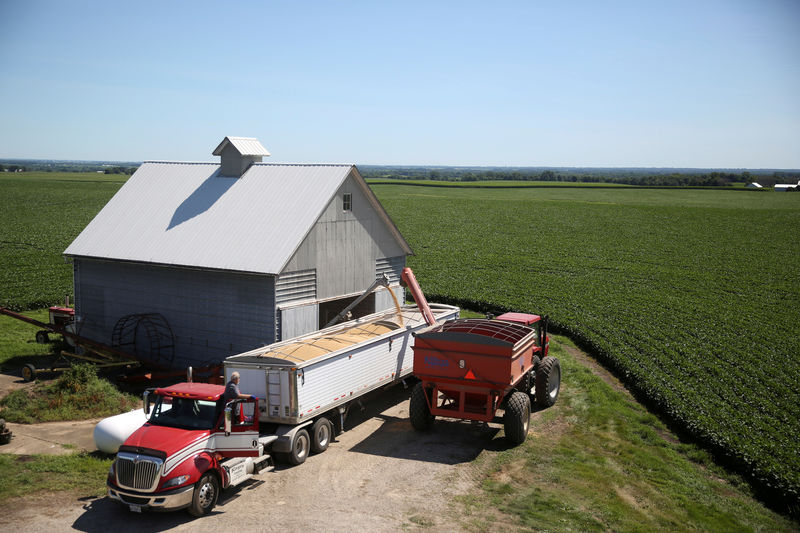By Michael Hirtzer
CHICAGO (Reuters) - Since the mid-2000s, North Dakota farmer Paul Thomas has planted more of his land with soybeans as China's demand for the oilseed grew. The shift culminated this year when Thomas planted 1,600 of his 5,000 acres with soybeans - the most ever.
But Thomas and many farmers like him plan to return to the old U.S. farm belt staples in 2019: corn and wheat. The change will reverse a trend that saw U.S. farmers plant more acreage this year with soybeans than corn for the first time in 35 years.
The expected shift to other grains comes as farmers struggle to sell the soybean crop because of President Donald Trump's trade war with China. China typically buys 60 percent of U.S. soybean exports but has bought almost none for months due to the trade war, pushing prices to a decade low.
Thomas plans to plant more wheat next year, hoping he can earn more by decreasing his reliance on the crop dependent on Chinese demand.
Soybean prices are "kicking our butts," said Thomas.
Without China, Thomas said local cash prices near his farm are $7.10 per bushel of soybeans, below the $8.50 necessary to cover costs.
The trade war has hit U.S. farmers at a vulnerable time. They had planted more acreage than ever with soybeans this year and are harvesting the largest ever U.S. crop.
But Beijing slapped an import tax on U.S. soybeans in July in retaliation for Trump's taxes on Chinese imports into the United States.
The first estimate for next year's planting by the U.S. Department of Agriculture (USDA) to include the impact of the tariffs later on Friday is expected to confirm early private estimates for fewer soybean acres.
U.S.-based Informa Economics on Oct. 19 forecast 2019 corn acreage, most of which will be planted starting around April, at 92.7 million acres (37.5 mln hectares), up 4 percent, and soybean acres down 7 percent to 83 million acres, according to a report seen by Reuters. Informa predicted U.S. wheat acres would rise 4 percent.
Acreage of soybeans, planted before retaliatory tariffs were imposed, rose to 89.6 million this year, up about 15 million acres from a decade ago.
Corn acres are up by less than 5 million acres since 2008 to 89.1 million acres while wheat acres of 47.8 million this year were near the lowest in a century.
Aron Carlson, president of the Illinois Corn Growers Association, devoted nearly half of his 3,600 acres to soybeans this year but plans to cut back.
He said he may increase corn planting by up to 20 percent at his farm in northern Illinois. The state is the biggest U.S. soy producer.
Soybeans yield fewer bushels per acre than corn but also require less fertilizer, making them generally cheaper to grow. A switch to corn could raise costs for farmers but benefit some companies including fertilizer sellers like The Andersons Inc. The firm's Chief Executive Pat Bowe told Reuters he expected a switch to corn would be good for fertilizer use.
Bayer AG (DE:BAYGN), too, expects to benefit from a switch to corn.
"Corn has a longer growing period, more issues with weeds and fungi ... This is a benefit for our overall business," Liam Condon, president of the company's Crop Science division, said at an event in St. Louis this week.
DEMAND DYNAMICS
While soybean prices tumbled to a decade-low on Sept. 18, corn is not frequently exported to China and slumped to merely a 22-month low. Wheat prices are up 19 percent this year as reserves in many exporting countries have fallen to their lowest level since 2007-08.
Corn demand has benefited from long-term growth in the livestock industry and grain-based ethanol. Drought in Brazil and Argentina also made corn importers more reliant on the United States.
A record 3.2 billion bushels of U.S. corn were consumed from June to September, the USDA said on Sept. 28.
Illinois farmer Eric Honselman said his family farm planted about equal amounts of corn and soybeans on their 5,600 acres. But corn acres next year will likely increase by up to 5 percent.
"Next year, we will be longer corn than soybeans," Honselman said. "Every time the market tells me to grow corn, I will do it."
